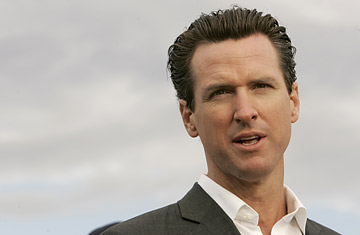
San Francisco's Mayor Gavin Newsom
Edwin Ramos had been in trouble before. In 2003, when he was 17, he was found guilty of attempted robbery and assaulting a San Francisco Municipal Transportation Authority passenger. Last March, he was detained for several days after police found in the car he was driving a gun used in a double homicide. And then came June 22, when Anthony Bologna's car prevented Ramos from turning left at an intersection. San Francisco police say Ramos opened fire with an AK-47 assault rifle, killing Bologna and his two sons, Michael and Matthew, who were driving home from a family barbecue.
Ramos, 21, is a native of El Salvador. He is an undocumented immigrant and an alleged member of the Mara Salvatrucha gang, also known as MS-13. And despite his previous scrapes with the law and his juvenile felony convictions, Ramos has never been deported — a fact that has put him at the center of a debate over San Francisco's so-called "sanctuary law."
Under the City of Refuge ordinance of 1989, San Francisco officials and police are not obligated to provide information to federal immigration authorities when they encounter an undocumented resident. Anti-immigration groups like Californians for Population Stabilization (CAPS) say sanctuary laws are allowing dangerous criminals like Ramos to crowd American prisons — or worse, remain on the streets. "There is a disproportionate number of people in our jails who are immigrants," says Diana Hull, CAPS president, who calls the sanctuary law the city's "rationalization" for not enforcing immigration laws. "They are not bad by virtue of where they come from; it's simply that the nice, middle-class Mexican population isn't that eager to come here." (The proportion of immigrants in U.S. jails is heavily disputed: a Public Policy Institute of California report found earlier this year that while 35% of adult Californians were born outside the U.S., only 17% of the state's adult prison population can make that same claim.)
City officials agree that Ramos should have been deported long ago but maintain that he fell through a loophole in what is an otherwise necessary and effective law. The sanctuary movement began in the 1980s, when many U.S. cities attempted to help hundreds of thousands of political refugees fleeing civil wars in El Salvador, Guatemala and Nicaragua who were denied official asylum status by the Federal Government. Since then, the laws have transformed into what is essentially a "Don't ask, don't tell" policy intended to improve relations between police and an immigrant community that does everything it can to operate under the radar. There is currently no law that requires state or local governments to cooperate with federal immigration efforts. In Los Angeles and San Francisco, police officers are not allowed to inquire about immigration status, in order to encourage victims of crimes to come forward without fear of deportation. "If the police become viewed as immigration enforcers, they're not going to get community assistance enforcing criminal laws," says Kevin Johnson, dean of the University of California at Davis Law School and an expert in immigration law.
San Francisco amended its sanctuary law in 1992, removing protections for criminal suspects. But in practice, police and justice departments would continually fail to turn over suspects to federal authorities. When the city's juvenile-court system was caught flying Hondurans convicted of dealing cocaine back to their home country last May — instead of contacting Immigration and Customs Enforcement (ICE) authorities to have them federally deported — Mayor Gavin Newsom changed the policy and told police officers that they should turn suspected criminals, even juveniles, over to authorities. "That policy was wrong," says Nathan Ballard, the mayor's director of communications. "The immigrant community must feel safe if they witness a crime; that's at the heart of this policy. But it will not be used as a shield for felons."
Since the Bologna murder, Newsom has ordered a "top-to-bottom review" of San Francisco's sanctuary policy. But the re-examination of the law has sparked a round of finger-pointing between city and federal governments. The San Francisco Sheriff's Department claims it turned Ramos' personal information over to immigration officers at ICE — who say they never received any documentation and only heard of Ramos after his release. "In the last 18 months, the sheriff has turned over 1,100 suspected felons to ICE," says Ballard. "This is the first time that ICE has ever complained about the way the sheriff handles immigration." A spokesman for ICE could not be reached for comment, although the organization said that at the time of his March detention, Ramos was already in the process of being deported.
Ballard blames the Federal Government for an immigration policy that he says does not follow through with its promises. "It is George Bush who has failed to secure our borders," he argues, "not Gavin Newsom." Meanwhile, the triple homicide has prompted conservative commentators including Rush Limbaugh, Bill O'Reilly and Lou Dobbs to weigh in — O'Reilly called the city of San Francisco "completely out of control and now directly responsible for the murders of three men" — while CAPS has blamed the deaths on the ACLU for its "rigor" in protecting the rights of prisoners. (The organization is not involved in the case.)
Meanwhile, San Francisco's sanctuary law remains "under review" by the mayor. As for Ramos, he is still in custody in San Francisco; he pleaded not guilty on July 23 and is awaiting trial.
